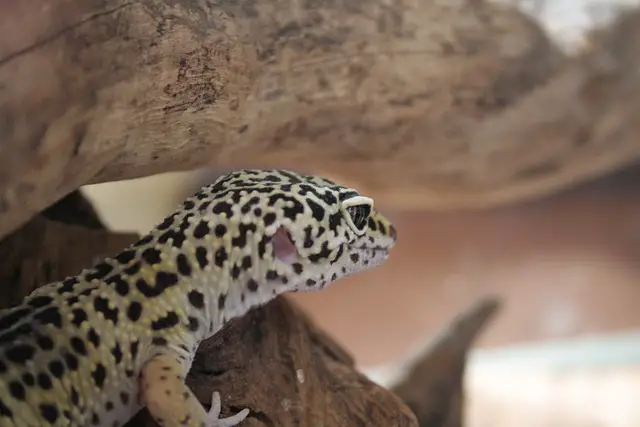When it comes to housing leopard geckos, many owners may wonder how many of these intriguing creatures can comfortably and safely live together.
This is an important consideration, as the social dynamics and territorial needs of leopard geckos can greatly impact their overall health and well-being.
This article will discuss the factors that should be considered when determining the appropriate number of leopard geckos to house together in a single enclosure.
In general, it is recommended that only one male leopard gecko should be housed in an enclosure, as they tend to become territorial and aggressive towards each other.
On the other hand, a single male can safely live with multiple females, provided there is enough space and hiding spots in the enclosure.
Female leopard geckos can coexist peacefully, but monitoring their behavior and grouping them based on size and age is crucial in preventing potential conflict or stress.
Gecko Community Living
Cohabitation Overview
Leopard geckos are solitary animals in the wild but can cohabit successfully in captivity under appropriate conditions. When considering housing multiple geckos together, optimizing the living environment to minimize stress and aggression is essential.
To promote harmony, ensure the following conditions:
- Adequate space: A minimum of 20-gallon tank for a pair, increasing 10 gallons per additional gecko.
- Multiple hides: Provide at least one hide per gecko placed in different enclosure areas.
- Abundant food and water: Offer separate feeding and watering stations to reduce competition.
Sex and Age Factors
The sex and age of leopard geckos play crucial roles in determining their compatibility. To avoid potential issues, follow these guidelines:
- Females only: A group of females usually coexist peacefully.
- No males together: Males are territorial and may fight, so never house them together.
- Male-female pairs: A male and female can live together, but breeding may occur, leading to potential stress for the female.
When mixing geckos of different ages, consider the following points:
- Size difference: Avoid housing geckos with significant size differences, as smaller ones may become victims of bullying or cannibalism.
- Juvenile geckos: Young geckos are best kept separate from adults until they reach a similar size.
By carefully considering these factors and providing an appropriate living environment, the cohabitation of leopard geckos can be successful.
Determining Housing Capacity
Enclosure Size
When determining how many leopard geckos can live together, the first factor to consider is the enclosure size.
The minimum recommended enclosure size for one adult leopard gecko is a 20-gallon tank (30 x 12 x 12 inches). For each additional gecko, you should add at least 10 gallons.
Here’s a quick reference table for housing capacity based on tank size:
| Tank Size (gallons) | Number of Leopard Geckos |
|---|---|
| 20 | 1 |
| 30 | 2 |
| 40 | 3 |
Providing ample space to prevent stress, competition for resources, and territorial aggression amongst the geckos is essential.
Gecko Size
The size and age of the leopard geckos also play a significant role in determining the housing capacity. Juvenile geckos grow rapidly and may require more space as they mature.
Adult males can be territorial, and it’s generally not recommended to house multiple adult males together, as they may fight over territory or females.
Adult females tend to be more compatible, but close monitoring is essential to ensure harmony.
When housing leopard geckos together, keep an eye on their behavior and physical health. Stress or aggression may indicate the need for enclosure or group composition adjustments.
Potential Risks of Cohabitation
Stress
Cohabiting leopard geckos may experience increased stress levels due to competition for resources like food, water, and hiding spots. Stress can weaken the immune system, making the geckos more susceptible to illness and less likely to thrive in their environment.
Aggression and Dominance
Leopard geckos can display aggressive behaviors towards each other, mainly when resources are uneven. This can result in fights between the geckos, causing injuries or even death. Male leopard geckos are known to be more aggressive and may engage in dominance battles, so it is advisable to keep them separate to prevent harm.
Health Concerns
Cohabiting geckos may spread diseases and parasites to one another. Sick geckos should be separated from healthy ones immediately to reduce the risk of spreading illness. Closely monitoring their health is essential when housing multiple leopard geckos to ensure their well-being.
Proper Care For Cohabited Geckos
Feeding Protocol
Establishing a proper feeding protocol is essential to ensure the health and well-being of multiple leopard geckos living together.
Feed them various insects, such as crickets, mealworms, and waxworms. Use appropriately sized feeders to avoid choking hazards—dust insects with calcium and vitamin D3 supplements to promote strong bones and overall health.
Feed juveniles daily and adults every other day. Monitor geckos during feeding time to avoid competition and guarantee each gecko receives adequate nutrition. If aggressive behavior is observed, separate the geckos during feeding.
Handling Tips
Leopard geckos are generally docile, making them easy to handle. However, when housing multiple geckos together, handling them individually and gently to minimize stress is crucial. Follow these handling tips:
- Wash your hands before and after handling to prevent the spread of bacteria.
- Approach geckos slowly to avoid startling them.
- Gently scoop them up from the side, supporting their entire body.
- Limit handling time to 15 minutes, as frequent or prolonged handling may cause stress.
Illness Prevention
To prevent illness among cohabited leopard geckos, maintain a clean and hygienic environment:
- Spot-clean the enclosure daily to remove feces and uneaten food.
- Perform a full enclosure cleaning, including disinfecting hides and dishes, every 2-4 weeks.
- Ensure proper humidity and temperature levels are maintained in the tank.
- Separate any gecko showing signs of illness or distress immediately and consult a veterinarian.
When followed correctly, these guidelines will contribute to the successful cohabitation of leopard geckos.




